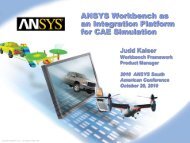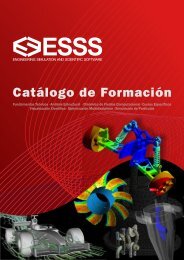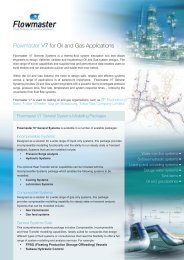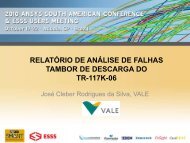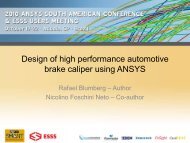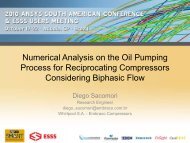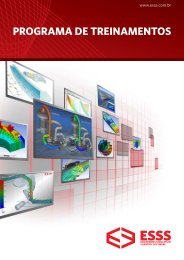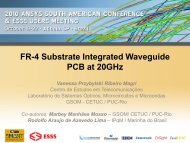analysis of a banana screen using edem and ansys - ESSS
analysis of a banana screen using edem and ansys - ESSS
analysis of a banana screen using edem and ansys - ESSS
Create successful ePaper yourself
Turn your PDF publications into a flip-book with our unique Google optimized e-Paper software.
ANALYSIS OF A BANANA SCREEN<br />
USING EDEM AND ANSYS<br />
José Cleber Rodrigues da Silva, VALE<br />
Daniel Schiochet Nasato, <strong>ESSS</strong>
SUMMARY<br />
• Overview – Vale<br />
• Introduction<br />
• Objectives<br />
• Material flow <strong>and</strong> forces <strong>analysis</strong><br />
• Conclusion
Overview – Vale<br />
• Vale is the world leader in iron ore <strong>and</strong> pellet production <strong>and</strong> the second<br />
biggest nickel producer.<br />
• Operating through <strong>of</strong>fices, operations, exploration projects <strong>and</strong> joint<br />
ventures, we are the second largest diversified mining company in the<br />
world <strong>and</strong> the biggest in the Americas by market capitalization.<br />
Headquartered in Brazil, we operate in 35 countries on five continents<br />
<strong>and</strong> employ over 60,000 people across the world.<br />
• We are present in Colombia, Chile, Argentina, Peru, Paraguay, Canada,<br />
the United States, Barbados, France, Norway, Switzerl<strong>and</strong>, the United<br />
Kingdom, Angola, Zambia, Mozambique, Guinea, South Africa, the<br />
Democratic Republic <strong>of</strong> the Congo, Gabon, India, China, Mongolia,<br />
Oman, Kazakhstan, Japan, South Korea, Taiwan, the Philippines,<br />
Thail<strong>and</strong>, Singapore, Indonesia, Malaysia, Australia <strong>and</strong> New Caledonia,<br />
in addition to Brazil
Our beliefs<br />
• Our mission<br />
To transform mineral resources into prosperity <strong>and</strong> sustainable development.<br />
• Our vision<br />
To be the largest mining company in the world, <strong>and</strong> to surpass the established<br />
st<strong>and</strong>ards <strong>of</strong> excellence in research, development, project implementation <strong>and</strong><br />
business operations.
Northern System<br />
• Consists <strong>of</strong> an integrated mine-railway-port system, which is made up <strong>of</strong> open-pit<br />
iron ore mines, an industrial treatment plant by the Carajás Railway (which is 892<br />
km long) <strong>and</strong> the sea terminal <strong>of</strong> Ponta da Madeira, in São Luís. From this<br />
terminal, the iron ore <strong>of</strong> Carajás is exported to clients all over the world.<br />
• Discovered in 1967, the Mineral County <strong>of</strong> Carajás has iron ore reserves <strong>of</strong><br />
approximately 16 billion tones. The high quantity <strong>and</strong> quality <strong>of</strong> the ore allows for<br />
a majority <strong>of</strong> the iron ore products to be generated solely through the stages <strong>of</strong><br />
grinding <strong>and</strong> classification.<br />
• Carajás has a production capacity <strong>of</strong> 100 million tones per year (Mat). To ensure<br />
the granulation adequacy <strong>of</strong> the products, the beneficiation plant is equipped with<br />
machines for grinding, humid sieving <strong>and</strong> classification <strong>of</strong> the ore. The ore goes<br />
through the following stages <strong>of</strong> production: primary crushing, secondary crushing<br />
<strong>and</strong> sieving, tertiary crushing <strong>and</strong> sieving, grinding, cycling <strong>and</strong> finally, the filtering<br />
<strong>of</strong> pellet feed. The objective <strong>of</strong> the beneficiation plant is to obtain three different<br />
grain thicknesses from the iron ore: pellet feed, sinter feed <strong>and</strong> granulated.
Introduction<br />
• Vibrating <strong>screen</strong>s are crucial on a mining plant;<br />
• Iron ore coming from crushing must be classified through a<br />
vibrating <strong>screen</strong>;<br />
• Structural problems on the <strong>screen</strong> may be caused through<br />
an incorrect or excessive feed;<br />
• EDEM simulations will be applied to help identifying<br />
problems related to incorrect feeding;
Objectives<br />
• Calculate separation efficiency, material height on the <strong>screen</strong><br />
<strong>and</strong> material velocity pr<strong>of</strong>ile;<br />
• Check if mass flow is appropriate;<br />
• Calculate forces on <strong>screen</strong> surface for further structural<br />
<strong>analysis</strong> with ANSYS.
Material data <strong>and</strong> initial conditions<br />
Material data Ore Rubber Steel<br />
Poisson's Ratio 0.25 0.25 0.25<br />
Shear Modulus 1,00E+06 1,00E+08 7,00E+10<br />
Density 4250 1300 7800<br />
Interaction data ore/ore ore/rubber ore/steel<br />
Coeff <strong>of</strong> restitution 0.2 0.3 0.3<br />
Coeff <strong>of</strong> static friction 0.6 0.65 0.5<br />
Coeff <strong>of</strong> rolling friction 0.25 0.25 0.2<br />
• Particle size distribution: 10 to 100 mm diameter<br />
• Mass flow: 4200 ton/h<br />
– 20 hours to simulate 18s in a dual core machine<br />
– About 280000 particles on domain
Dynamics<br />
• 7mm displacement<br />
• 880 rpm
Material height <strong>and</strong> size pr<strong>of</strong>ile<br />
• Particles are colored by mass • A slice was applied in the sieve<br />
• Average 115mm material height
Size <strong>analysis</strong> by regions<br />
Withheld<br />
Passing<br />
• The <strong>screen</strong> was split into passing <strong>and</strong> withheld material;<br />
• Small particles separation was analyzed.
Small particles<br />
• Withheld small particles:<br />
• About 14% <strong>of</strong> small particles are<br />
withheld<br />
• Passing small particles<br />
• 86% <strong>of</strong> small particles pass<br />
through the sieve
Force pr<strong>of</strong>ile<br />
• Total force on the <strong>screen</strong> was calculated:<br />
• Reached up to 170 KN
Velocity pr<strong>of</strong>ile<br />
• Velocity pr<strong>of</strong>ile on <strong>screen</strong>.
Velocity on bin group<br />
• Bin group on <strong>screen</strong>.<br />
• Average velocity on bin group:<br />
• 0.76 m/s on flow direction (x)
Conclusions<br />
• EDEM captured material flow through the sieve;<br />
• Some small particles are being withheld in the sieve:<br />
– Can be caused by an excessive feeding<br />
• Forces on the <strong>screen</strong> were calculated on EDEM;<br />
• These forces will be used in ANSYS to evaluate possible<br />
structural failures on <strong>screen</strong> due to incorrect material flow.



